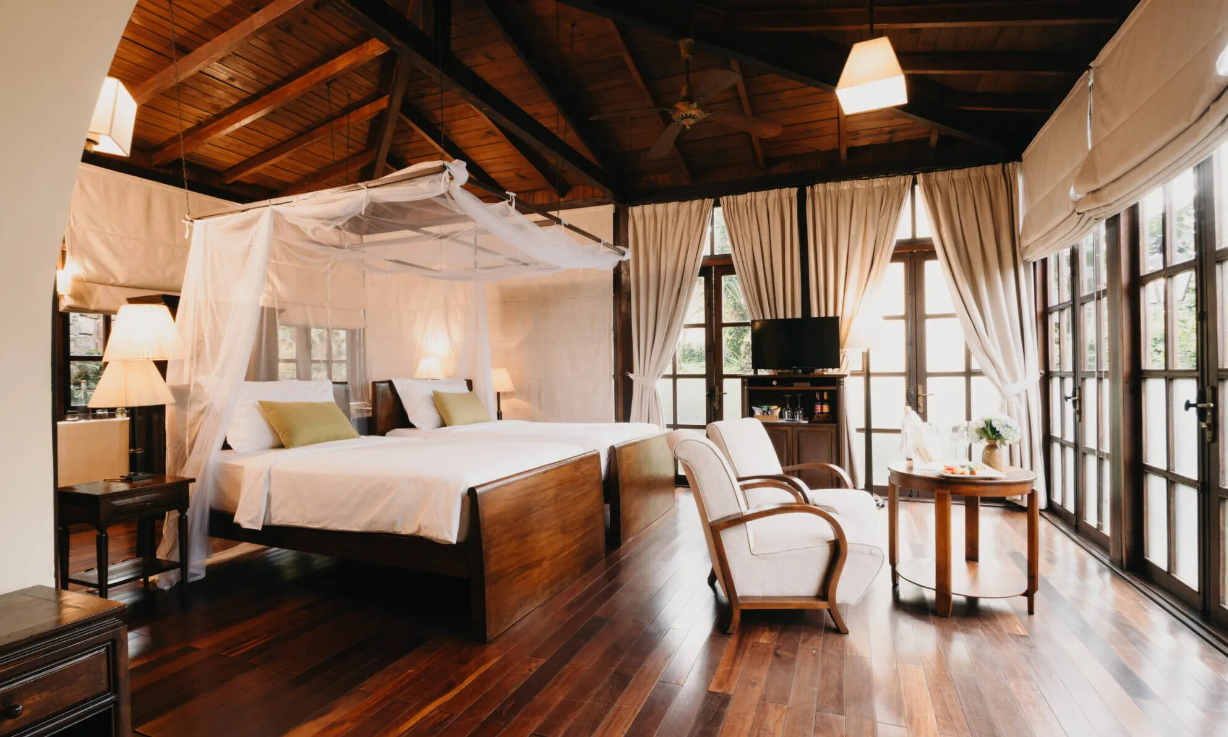A summer hideout for the French colonialists, cool climate, mystifying landscapes, a crazy house and a hell market are part of what makes Da Lat a special travel proposition.
WHAT TO EXPLORE
Among the many “titles” Da Lat has garnered over the years is “Little Paris,” given the heavy French influence not so long ago.
There are an estimated 1,500 old villas that the French built over a century ago as a getaway when summer got really hot elsewhere.
So it is not a bad idea to have the French village on Le Lai Street be the first stop in a tour of the Central Highlands town.

Spreads over 17 hectares on a pine hill to the northwest of downtown Da Lat, the village was once named after Jean Oneil, a colonel in French Army in Indochina.
After retiring in 1920, Jean decided to choose the Cam Ly area in the north of Da Lat to build his plantation and a dam to provide water for his residence. He invited French architects to design the entire place.
Initially, 15 villas were built and two more were added later.
Each villa has three to seven guest bedrooms, all preserved in almost their original state today, from floors and fireplace to electric plugs. Tourists can book one-day tour to visit ancient villas in the village.
For VND170,000 ($7.33) per person, you can enjoy a European-style afternoon tea with cakes and fruits after visiting the villas. A tour package of VND320,000 will include an Asian-style lunch.
The Hang Nga Guesthouse, also called “Crazy House” has emerged as a popular tourist attraction that the Lonely Planet has listed among the 120 most breathtaking human constructions on earth.

Situated around one kilometer from Da Lat, the guesthouse opened in 1990, and has been compared to the amazing architecture of world-acclaimed constructions such as the Salvador Dalí Museum and Walt Disney Concert Hall.
Once forgotten, it now attracts hordes of tourists who pay VND60,000 ($2.25) for a ticket to enter the place and satisfy their curiosity.
Australian citizen Stephen who visited Da Lat earlier this month said the building reminded him of something out of Lord of the Rings or The Hobbit movies.
“It is amazing to explore the building. If you had kids, they would not leave this place for hours. The architecture and design is amazing,” he said.
Another highlight of French heritage is the Da Lat Railway Station built by French architects in 1932. When it opened in 1938, the station was part of the Thap Cham – Da Lat railway line, running from the former coastal Champa Kingdom in Ninh Thuan to Da Lat.

It has been crowned as the oldest and most beautiful railway station in Indochina with a touch of French architecture. But after French troops withdrew from Vietnam in 1954, people stopped using the trains and the tracks were dismantled by people looking to sell scrap metal.
A section of the track, seven kilometers long, has been relaid and steam engine trains now run from Da Lat to Trai Mat, taking visitors to the Linh Phuoc Pagoda.

The Linh Phuoc Pagoda, situated around seven kilometers to the west of the station, piques the curiosity of visitors, especially foreigners, with its colorful appearance made up of tens of thousands of pieces of porcelain.

Though the materials used are scrap, the craftsmanship on display is impressive.
“Amazing pagoda! Well worth the visit! Beautiful and detailed designs and intricate tiled walls, ceilings and floors,” Lily from the U.K. has written on Tripadvisor.
Just 30 minutes drive from the pagoda is the Cau Dat tea plantation, established in 1927 by the French.

You can rent a car to visit the tea plantation for VND80,000 – 100,000 a day.
In Cau Dat stands a factory that has been making tea for almost 100 years. It is considered the oldest tea factory in Southeast Asia that is still operating. The machines in use were imported directly from Europe.
The Langbiang Mountain at 2,169m above the sea level is considered the roof of Da Lat. It is famous for the spectacular views it offers overlooking the entire town.

It is also home to some of the oldest ethnic minority groups in the Central Highlands. Visiting a local village is an opportunity to witness firsthand a culture and lifestyle that has stood unchanged for generations.
A trek through peaceful pine forests to the top of Langbiang takes about three to four hours. It gets cooler as one gets further up and the vegetation gets dense. Those short of time or unable to trek for other reasons can take a jeep ride for VND100,000 to VND120,000 for a group of four. A one-way trip takes 15 minutes.
At the foot of the mountain, having a family meal with the Lach ethnic minority community, one of the first inhabitants of Da Lat, is a highly recommended experience.
Visitors will be treated to ruou can, a local wine stored in a big jar and drunk with long bamboo straws, not to mention the enjoyment of joining gong dances with local villagers around campfires.
Back in Da Lat, a walk around the night market, also known as “Hell Market,” is a pleasant experience. The market is said to get its name from the past when there were no electrical lights and sellers used oil lamps.

Hoa Binh Street leading to Da Lat night market swarms with visitors during the Hung Kings’ holiday in April 2022. Photo by Pham Anh Tai
Today, it is a popular hangout to shop for clothes and tuck into local specialties like warm, fresh soymilk and artichoke tea, sweet tofu custard in ginger sauce, grilled scallops, chicken porridge, steamed corn and banh trang nuong (grilled rice paper).
WHERE TO STAY
Hotels near the downtown area and the Da Lat night market, which makes transportation convenient, can be booked for VND150,000 to VND250,000 per night.
Homestays are also worth considering. Jang & Min’s house, The Barn Home Farm, Moonrise Garden Dalat, and Dalat Lacasa Homestay II are places with good reviews. Prices range from VND70,000 to VND300,000 ($3-12.85) per night.
To stay in the French built villas, the Sam Tuyen Lam Resort, Ana Mandara Dalat and Binh An Village Resort are options where prices start at VND2.5 million a night.
WHAT TO EAT
It is said that no one should leave Da Lat without having tasted banh can, a mini pancake made with rice flour. Situated at the end of the steep Tang Bat Ho, one place has been serving the treat with two options – quail egg and duck egg – for over 15 years.

Banh mi xiu mai, pork meatballs in hot gravy sauce with crispy bread, is ideal for breakfast or lunch.
Though there are many places that offer this dish, Vi Nguyen, born and raised in Da Lat, prefers a small food stand on Hoang Dieu Street.
“Banh mi xiu mai here is served within seconds by a lovely local lady, the sauce is very greasy and savory. She also sells Vietnamese bread (banh mi) that many locals come by to pick up before work every day. The food stall only opens until noon.”
You can find the eatery, Banh mi 79, on the sidewalk every morning from 6.30 a.m. A banh mi xiu mai costs VND15,000 ($0.65).
In the town’s foggy landscape and chilly weather, a fish hotpot at a restaurant on Nguyen Chi Thanh Street is also highly recommended. The place is always crowded at night.
The restaurant owner said the soup is made with freshly cut fish cooked with Vietnamese vegetables in a large pot with a little fermented wine. The soup is had with rice cooked in a clay pot.
Apart from this special serving, you can order other Vietnamese dishes for VND50,000 to VND350,000 ($2-15). The restaurant is open all day.
Another dish to savor in Da Lat is grilled pork roll, which is made by folding minced pork around a bamboo section. After it is grilled, it is rolled in rice paper with pickles and herbs. The most essential thing again for this is the dipping sauce, a special mixture made with pig liver, shrimp, pork and ground bean paste.
BEST TIME TO VISIT
Located at 1,500 meters above sea level, Da Lat is famous for its year-round cool climate and can be visited at any time of the year.
Between November and May is the dry season when there is less rain, making it convenient for visitors to enjoy outdoor activities like trekking and kayaking.
The ideal time to go “cloud hunting” is between April and June. This is the time when thick clouds and fog envelop mountaintops and valleys.
HOW TO GET THERE
From Hanoi and Saigon, the best way to reach Da Lat is by air.
Vietnam Airlines and Vietjet Air have direct flights to Da Lat every day. Return tickets cost around VND1.1 million ($47) from HCMC and VND2.4 million ($103) from Hanoi.
The Lien Khuong International Airport is around 40 kilometers from the town. A shuttle bus or cab takes visitors from the airport to the town.
A sleeper coach from HCMC that takes around eight hours to reach Da Lat costs VND220,000 ($9.42) per person.



















